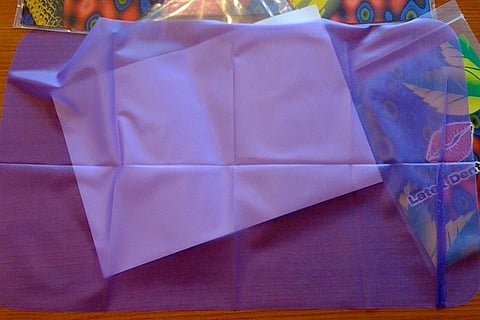

On a public holiday, when all the folks were deep into their siestas, we were nervously fumbling with a condom while a sex-ed website was open on a dusty laptop. We took the awkwardness of sexual experimentation and ambitiously turned it into a checklist – “let’s try everything.”
Inexperience didn’t stop us. We pored through medical journals on sexology and surreptitiously slurped up The Kamasutra in bookstores, wary of the nosy aunty. We wanted to be clinical about it, and we wanted to get it all right.
While researching forms of protection, lubricants and aphrodisiacs, a piece of latex caught my eye.
I stretched out the practice condom and cut it up, placing it on my tongue. “It’s a dental dam,” I said, wiggling my tongue and gagging from the aftertaste of latex. “It’s also the opposite of an aphrodisiac,” he sniggered.
He’s not wrong, no one really uses it, and it’s a fantastic way to turn off your partner. Dental dams are an oft misunderstood piece of latex or silicone, and if you thought it was hard to get men to wear a condom, this one’s impossible.
Condoms were designed with sex in mind, while dams were originally created to help dentists focus on a particular part of the mouth during an oral procedure.
It made an appearance at the hilt of the 1980s during HIV awareness drives.
The dental dam is designed to serve as a barrier during cunnilingus and analingus. But many people — straight and lesbian — don't even know what a dam is, forget how to use it.
A dental dam can help reduce the risk of STD transmission – including herpes, genital warts (HPV), and gonorrhoea.
To wear it properly, a person needs to hold the dam firmly over their vulva or anus. Lube is recommended, but not required. If not held firmly, it could choke your partner, trust me. Rubber isn’t a great taste, so most cut up flavoured condoms.
Its biggest audience is lesbian women, who at the time, were disproportionately low risk groups. Marketed to straight and lesbian couples, a 2010 study found that less than 10% of lesbian women in the USA have ever used them, and less than 2% regularly use them.
Online forums are chock-full of information on dental dams, but the questions focus more on the stress around contracting a possible STI, or even cancer. Homosexual relationships carry a lot of stigma as it is, and the use of dental dams are sometimes driven by the stress of contracting STIs, and this significantly takes away from the experience.
It grew to be a fetish for me, but not for long. While it’s foregone now, dental dams still have a following in sections of the queer community in India, particularly those who indulge in casual sex.
It does dull sensation, and the unpleasantness supersedes the risk. But what’s powerful about the dental dam is the symbolism it carries for lesbian and queer couples.
Like straight men and women have condoms and diaphragms, or gay men have condoms, lesbian and queer couples have something to call their own.